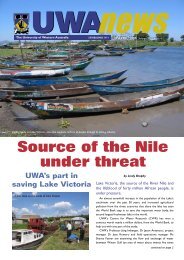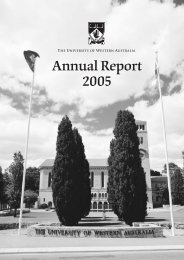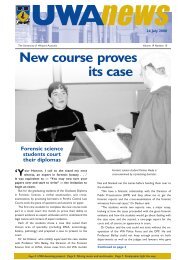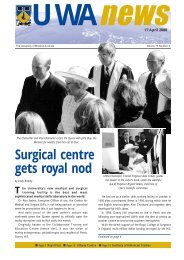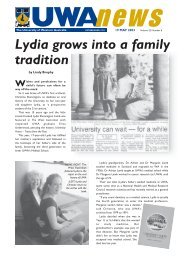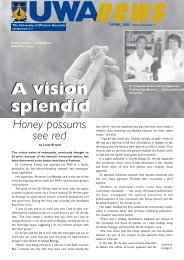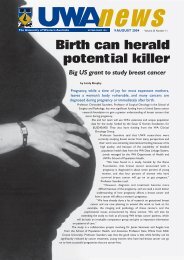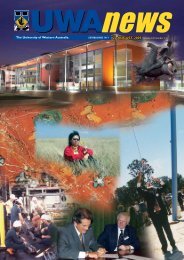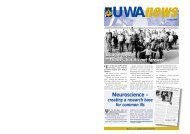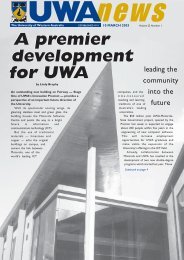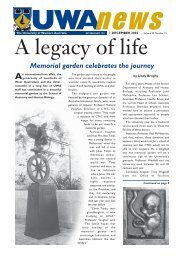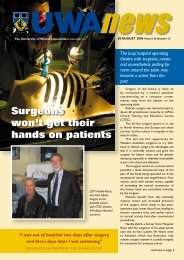6 UWA<strong>news</strong>a fortress cityuncoveredDesert sand gives upa 2,000 year old city …Archaeologists <strong>of</strong> the 21st century tend to get more excited by thescrapings <strong>of</strong> a domestic fireplace than the statues from a temple.“Of course everything is precious and vital to building up a picture <strong>of</strong> a community,but these days, we are more interested in the environment and the ecology <strong>of</strong> aparticular place and time, rather than the public life <strong>of</strong> a community,” said eminentarchaeologist Pr<strong>of</strong>essor Graeme Clarke (pictured right), who visited UWA recently.Pr<strong>of</strong>essor Clarke, the Australian Archaeological Institute at Athens Visiting Lecturerfor 2002, presented some <strong>of</strong> his past 16 years’ work in Syria at a public lecture for theSchool <strong>of</strong> Humanities (Classics and Ancient History).Since 1986, he has been leading an excavation <strong>of</strong> the abandoned Hellenistic city <strong>of</strong>Jebel Khalid on the west bank <strong>of</strong> the Euphrates River in North Syria, about 60kilometres south <strong>of</strong> the Turkish border.He discovered the lost city while conducting a survey for a Melbourne team <strong>of</strong>archaeologists who were excavating a Bronze Age site further up river.“I came across some pottery pieces, which eventually led me to the remnants <strong>of</strong> acity wall, and I realised what I had found,” Pr<strong>of</strong>essor Clarke said.Excavation <strong>of</strong> the site began two years later and Pr<strong>of</strong>essor Clarke, who was then apr<strong>of</strong>essor <strong>of</strong> classical studies and Director <strong>of</strong> the Humanities Research Centre at theAustralian National <strong>University</strong>, got together a team which goes to the site every yearfor two months.“We have to employ a guard for the other 10 months <strong>of</strong> the year. But it’s just notpractical to work at the dig for longer than that period each year,” he said.“For a start, the conditions are very hard and it’s difficult to get a team <strong>of</strong> expertstogether for any longer than a couple <strong>of</strong> months.“Each year the team we take with us might include an illustrator, a photographer, aconservator, an architect, a surveyor, metal, glass and coin experts and a botanist. Wetake between 15 and 18 people and employ up to 90 locals at the site. It looks likeRaiders <strong>of</strong> the Lost Ark when we’re at full strength!”Jebel Khalid was a Greek fortress 30 hectares in area built on a limestone plateau atthe beginning <strong>of</strong> the third century BC.“It was newly conquered territory for Alexander the Great and the city was a“<strong>The</strong> charcoal remainsfrom the fireplaces tell uswhat wood grew in thearea so we know howdamp it was. Soil samplescan also tell us what sort<strong>of</strong> plants grew and we canbuild up an ecologicalpicture…”THE UNIVERSITY OF WESTERN AUSTRALIA • 4 NOVEMBER 2002
UWA<strong>news</strong> 7military colony built to guard a rivercrossing,” Pr<strong>of</strong>essor Clarke explained.“It was abandoned in the first half <strong>of</strong> thefirst century BC when the Greekdynasty collapsed and the Romanschanged their protection strategies.“Jebel Khalid was not the sort <strong>of</strong> placeyou would stay in if it no longer had a use.Everybody lived inside the fortress wherethere was no natural water and thepeople all had to leave the fortress to goout and work in their fields, then comeback in again at night.“Being an abandoned city means thatwhat we are finding is their rubbish,what they didn’t want and what theyfound too heavy or awkward to takewith them. It is all covered in 2,000years <strong>of</strong> dust and sand.”But, slowly, Pr<strong>of</strong>essor Clarke and histeam are building up a picture <strong>of</strong> theenvironment on this plateau on thebanks <strong>of</strong> the Euphrates, more than2,000 years ago.“We have found olive pips and grapeseeds preserved in the fireplaces, so weknow they grew them. <strong>The</strong> charcoalremains from the fireplaces tell us whatwood grew in the area so we knowhow damp it was. Soil samples can alsotell us what sort <strong>of</strong> plants grew and wecan build up an ecological picture.”It has taken around 13 years toexcavate about 10 domestic houses ona large block. <strong>The</strong>y have learned aboutthe women’s activities at home whilethe men worked the fields, findingevidence <strong>of</strong> spinning, weaving andcooking.“We are interested in finding outhow people lived, their culinary habits,their diets, so we go first for domestichomes rather than public buildings.“We have found a lot <strong>of</strong> stew potswhich means they didn’t eat theiranimals until the end <strong>of</strong> the stock’suseful life. <strong>The</strong>y would have used theirsheep, goats and horses for carryingloads and providing milk for cheese andyoghurt, and for wool. <strong>The</strong> only younganimals they slaughtered were pigs andthe native gazelle.”Pr<strong>of</strong>essor Clarke said his teamworked ‘fiendishly hard’ every Marchand April, rising at 4.30am, working atthe dig until midday, then spending theafternoon analysing, conserving andcataloguing their finds until the lightfaded.“Essentially, we work a double shiftevery day. And living in a Bedouin villagein the heat and dust where we mustcommunicate in Arabic with the localsand share two showers between 18people makes it hard going.”He said they had found coins at thedig from the fourth century AD.“<strong>The</strong>se were dropped by what we callstone robbers. A lot <strong>of</strong> the stone hasbeen taken from the city. <strong>The</strong>re isevidence that tractors came in duringthe 20th century to take stone away.“<strong>The</strong> French encouraged theBedouins to become sedentary. Somany <strong>of</strong> them robbed the city <strong>of</strong> itsbuilding blocks, to provide theirpermanent homes. It’s still happening.When we were there this year, somelocals came to take away some stoneblocks because somebody in theirvillage had died and this is how theybury them, under stone blocks.”Everything the team unearths at JebelKhalid belongs to the Syriangovernment. <strong>The</strong> major pieces go tothe museum at Aleppo, the nearest cityand the second biggest city in Syria, afterDamascus.“But they are only interested inwhole pieces. As it’s an abandoned site,there are plenty <strong>of</strong> broken plates, whichare fine for the information they cangive us, but not for display in a museum.“<strong>The</strong>re are many more years <strong>of</strong> workin the dig but eventually, we willprobably get permission to take some <strong>of</strong>the unwanted pieces out <strong>of</strong> the country.In the meantime, they stay in storage,”he said.Pr<strong>of</strong>essor Clarke explained that histeam would not excavate the entire site.“<strong>The</strong>se days we leave something forthe archaeologists who come after usbecause they’ll be looking for differentthings,” he said. “Thirty years ago, wewouldn’t have been interested in theecology and environment <strong>of</strong> a site; wewould have been looking at differentaspects. And it will change again.“So we only ever ‘sample’ a site now.We have only excavated one <strong>of</strong> the 30columns in the fortress wall. We don’tneed to unearth all 30 because they willall tell us the same thing.”As the visiting pr<strong>of</strong>essor for theAustralian Archaeological Institute atAthens (AAIA), Pr<strong>of</strong>essor Clarke istouring Australia and visiting all theuniversities which support the AAIA.“I am very pleased to report that theclassical studies departments around thecountry are hanging on. <strong>The</strong>y seem tohave stabilised after being under threatfor a while. But who knows what willhappen in the future?”Graham Clarke on sitein SyriaTHE UNIVERSITY OF WESTERN AUSTRALIA • 4 NOVEMBERS 2002



